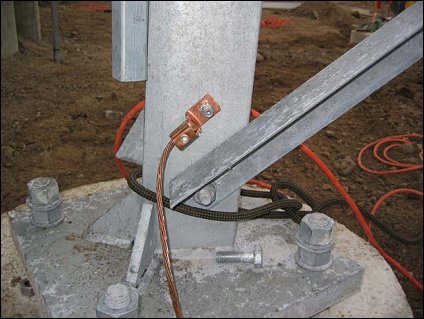| Wireles Networking is a practical guide to planning and building low-cost telecommunications infrastructure. See the editorial for more information.... |

|

Home  Networking Hardware Networking Hardware  Professional Lightning Protection Professional Lightning Protection |
|||
| See also: Surge and Lightning Protection | |||






|
|||
|
Professional Lightning ProtectionThe only natural predator of wireless equipment is lightning. There are two different ways lightning can strike or damage equipment: direct hits or induction hits. Direct hits are when lightning actually hits the tower or antenna. Induction hits are caused when lightning strikes near the tower. Imagine a negatively charged lightning bolt. Since like charges repel each other, that bolt will cause the electrons in the cables to move away from the strike, creating current on the lines. This is much more current the the sensitive radio equipment can handle. Either type of strike will usually destroy unprotected equipment.
Protecting wireless networks from lightning is not an exact science, and there is no guarantee that a lightning strike will not happen, even if every single precaution is taken. Many of the methods used will help prevent both direct and induction strikes. While it is not necessary to use every single lightning protection method, using more methods will help further protect the equipment. The amount of lightning historically observed within a service area will be the biggest guide to how much needs to be done. Start at the very bottom of the tower. Remember, the bottom of the tower is below the ground. After the tower foundation is laid, but before the hole is backfilled, a ring of heavy braided ground wire should have been installed with the lead extending above ground surfacing near a tower leg. The wire should be American Wire Gauge (AWG) #4 or thicker. In addition, a backup ground or earthing rod should be driven into the ground, and a ground wire run from the rod to the lead from the buried ring. It is important to note that not all steel conducts electricity the same way. Some types of steel act as better electrical conductors then others, and different surface coatings can also affect how tower steel handles electrical current. Stainless steel is one of the worst conductors, and rust proof coatings like galvanizing or paint lessen the conductivity of the steel. For this reason, a braided ground wire is run from the bottom of the tower all the way to the top. The bottom needs to be properly attached to the leads from both the ring and the backup ground rod. The top of the tower should have a lightning rod attached, and the top of that needs to be pointed. The finer and sharper the point, the more effective the rod will be. The braided ground wire from the bottom needs to be terminated at this grounding rod. It is very important to be sure that the ground wire is connected to the actual metal. Any sort of coating, such as paint, must be removed before the wire is attached. Once the connection is made, the exposed area can be repainted, covering the wire and connectors if necessary to save the tower from rust and other corrosion. The above solution details the installation of the basic grounding system. It provides protection for the tower itself from direct hits, and installs the base system to which everything else will connect. The ideal protection for indirect induction lightning strikes are gas tube arrestors at both ends of the cable. These arrestors need to be grounded directly to the ground wire installed on the tower if it is at the high end. The bottom end needs to be grounded to something electrically safe, like a ground plate or a copper pipe that is consistently full of water. It is important to make sure that the outdoor lightning arrestor is weatherproofed. Many arresters for coax cables are weatherproofed, while many arresters for CAT5 cable are not. In the event that gas arrestors are not being used, and the cabling is coax based, then attaching one end of a wire to the shield of the cable and the other to the ground wire installed on the towers will provide some protection. This can provide a path for induction currents, and if the charge is weak enough, it will not affect the conductor wire of the cable. While this method is by no means as good of protection as using the gas arrestors, it is better then doing nothing at all.
|
|||
Home  Networking Hardware Networking Hardware  Professional Lightning Protection Professional Lightning Protection |
|||
Last Update: 2007-01-25


